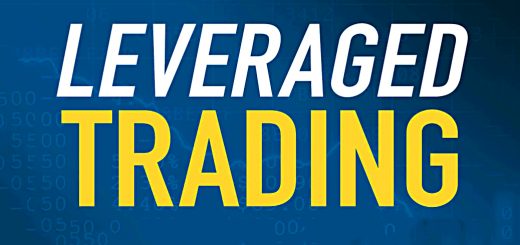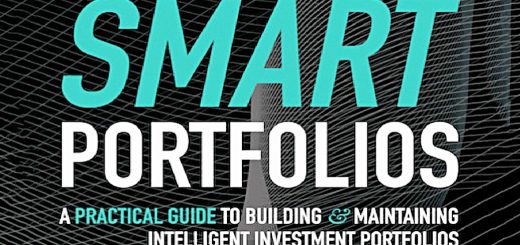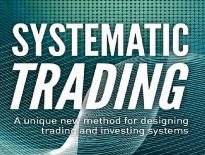Systematic Trading 5 – Speed

Today’s post is our fifth visit to Robert Carver’s book Systematic Trading.
Contents
Speed
Speed of trading depends on:
- how you expect prices to move
- how much it costs you to trade
Rob has a table explaining the various types of transaction costs:
- costs per block(spread and slippage)
- fee per ticket (commission)
- trade size fees (in futures)
- percentage value fees (eg. stamp duty, or commissions on larger trades)
There are also holding costs (for futures, spread bets, and ETFs / ITs), but these don’t affect the trading speed decision.
In standardising costs, Rob once again uses volatility standardisation.
- He wants to know how much it will cost to buy a unit of risk.
His basic unit – the standardised cost – is the cost of a round trip (buying and selling) for one instrument block.
- He measures this in terms of how much of your annualised SR you will lose for this trip.
This is the (buy cost + sell cost) divided by the (annualised standard deviation of the value of one block of an instrument).
- The annualised SD is 16 times the daily volatility.
So low vol instruments are in general more expensive to trade – yet another reason that Rob avoids them.
Rob starts with a futures example:
- The Euro Stoxx future has 1.5% daily volatility.
- And a 1% move is worth €337, so the daily volatility is €506.
- The annual volatility is €8,096.
- A trade costs just €8 per block, so a round trip is €16.
- This works out at 16/8096 or 0.002 SR units.
This is very cheap.
- Rob says that futures costs range from 0.001 SR up to 0.030 SR.
His next two tables show the daily volatility calculation for a £1 per point spread bet on the FTSE 100, and the costs.
The spread bet works out at 0.010 SR.
- This is 10 times the equivalent future.
- Rob says that most bets on major indices work out about the same.
Rob uses quarterly forward bets as spot bets work out more expensive for his typical holding period.
Next up is the volatility for an ETF, for which Rob uses a 100 share block (a $14K trade for the very expensive ETF he chooses – IGIL).
This ETF works out at 0.080 SR.
- More volatile (stock-based) ETFs work out cheaper, but Rob uses 0.080 SR for all ETFs, just to be safe.
Turnover
The next thing we need is a standardised measure of trading speed.
- Rob uses the number of buys and sells of the expected average position in an instrument.
- This is his measure of turnover.
A turnover of one implies one round trip (one buy and one sell) of one average position size per year.
- This makes your average holding period one year.
- A turnover of 26 would imply a holding period of two weeks.
If a round trip costs 0.010 SR and you have a turnover of 10, then your annual costs are 0.100 SR.
- That means that a system with an SR of 0.5 will return 0.4 SR after trading costs.
Rob provides a table of reasons to trade.
- Changes in forecasts and price volatility are the key drivers.
There are three ways of estimating turnover:
- sophisticated back-test
- simple back-test
- rule of thumb
I hope we can make do with the rules of thumb (to be presented later).
Speed limit
Rob takes us back to the Euro Stoxx future, which had a standardised cost of 0.002 SR.
- If you have a trading rule with a pre-cost SR of 0.4 which generates 50 round trips per year, the annual cost is 50 * 0.002 = 0.1 SR
- The net SR drops to 0.3
Another rule with SR 0.6 and a turnover of 100 would generate costs of 0.2 SR.
- But the net SR would still be higher at 0.4.
Rob is sceptical that the net SR will be achieved, reminding us that you need a lot of data to prove that one rule has a higher SR than another.
He also points out that higher historical costs might have prevented “better” rules from being implemented.
- Now they are cheap enough to use, the effects they exploit might vanish.
Rob recommends that we use a speed limit of one-third of expected profits (gross SR).
- Since most sub-systems will have an SR below 0.4, this means an annual cost limit of 0.13 SR.
For the Euro Stoxx future, that means 0.13 / 0.002 = 65 round trips or a holding period of around four trading days.
- Rob says that NASDAQ futures are even cheaper, and might support a holding period of a couple of days.
But day-trading is out.
And even approaching Rob’s limits is expensive.
- With a volatility target of 25%, 0.13 SR works out at annual trading costs of 3.35% pa.
- That’s quite a drag on performance.
Rob provides a table showing how costs should influence your decision-making when putting together a trading system.
Instrument speeds
Semi-automatic and asset-allocating investors should expect a maximum SR of 0.25, and use a cost limit of 0.08 SR.
Rob’s next table gives the recommended holding periods for various instruments.
Some of these results are pretty scary:
- ETFs need to be held for at least six months, and individual stocks should be held for upwards of 2.5 years.
- Index spread bets should be held for 6.5 weeks, and stock spread bets for three months.
- Futures only need to be held for one month
There is a similar table for system traders.
This is harder to interpret since we are not familiar with the turnover of various trading rules.
- Later in the book, Rob will provide a set of rules with an average turnover of 12.5 round trips per year.
- This means a maximum cost of 0.01, which is fine for futures and index spread bets – but not for ETFs.
It looks as though some rules will need to be implemented via spread bets, and others via ETFs.
- Rob says that rules with a turnover of more than 13 should be rejected by traders using spread bets.
Stop losses
Rob recommends that exits are decided by stop losses.
- This means in turn that holding periods depend on how tight the stops are set.
The wider your stops, the more expensive the instruments that you will be able to trade.
Weighting rules
Higher turnover (more expensive) rules should have lower weights, especially for expensive instruments.
With hand-crafting, this involves adjusting weights to account for lower net SRs.
- Rob has provided tables for this in both of his books, but we haven’t needed them until now.
Since Rob has excluded rules that cost more than 0.13 SR per year, and the process involves comparing a rule to the average of all the others, in practice the weightings will only be adjusted by +/- 5%.
- So we can probably ignore this step.
Price volatility
Rob uses an EMA of price changes to determine price volatility.
- He uses a 25-day EMA since longer periods (particularly over 20 weeks / 100 days) give a poorer performance.
Instrument weights
Rob notes that expensive instruments usually perform better after costs, but only when traded slowly.
- Faster trading of expensive instruments is already ruled out by the speed limits on annual SR costs.
He recommends assuming the same post-cost SR for all trading subsystems.
- That way, no SR adjustment is needed to account for different cost levels.
Summaries
Rob ends the chapter with some summary tables.
- First, the standardised cost estimate.
- Next, how to calculate costs.
- Then how to cope with costs.
- Finally, how to deal with having a small amount of capital:
Conclusions
It was pretty hard going today, but that completes the theoretical part of the book.
- All that remains its to look at example systems for Rob’s three types of investor.
Until next time.















